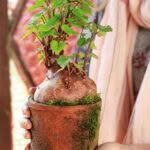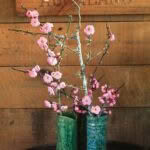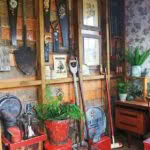Lynda Hallinan’s Blog: The charm of a barn
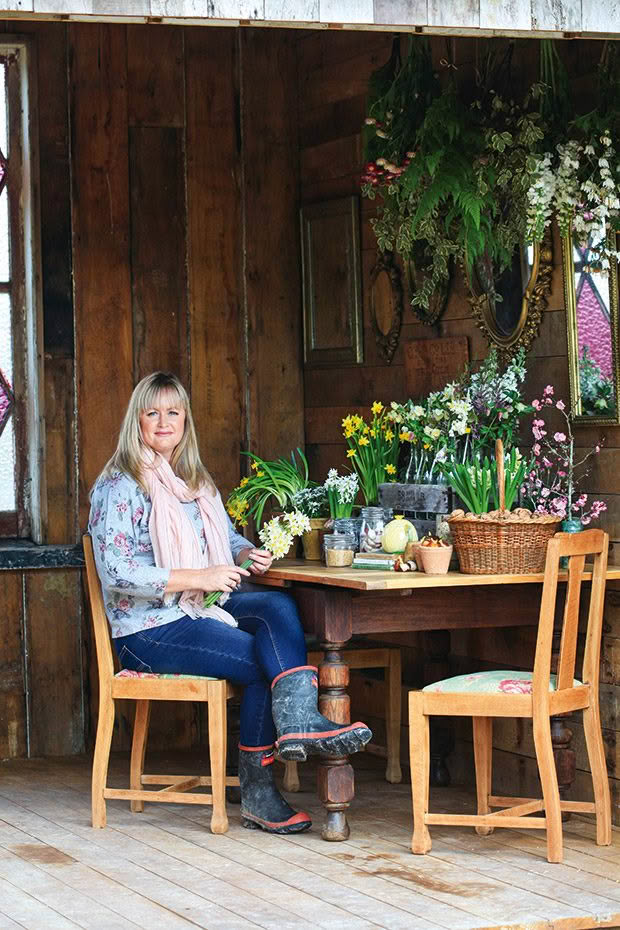
This garden-lover’s pet project sees a rundown barn turned into a room of her own.
Words: Lynda Hallinan Photos: Sally Tagg
Forget about sugar and spice and all things nice. When I was a girl, I begged my parents to buy me a Barbie doll for my birthday, only to unwrap a massive box of Lego blocks. I didn’t know it then, but as my sister and I designed, demolished and rebuilt teeny-tiny Brutalist homes for our Smurf figurines, we were pioneers of zero-waste deconstruction.
What goes up often comes down again, but if you do the job gently, most – if not all – of the original materials can be salvaged and sustainably repurposed instead of being trucked off to the tip. My thrifty nana Pat was forever unpicking and reknitting old cardigans to keep up with the fashions of the day. And we gardeners are notorious upcyclers of everything from kitschy tyre swans to window-pane winter cloches and vertical pallet gardens.
Remember the Whole House Reuse Project? In the wake of the Christchurch quakes, a 1920s weatherboard three-bedder facing the wrecking ball in New Brighton was carefully dismantled and creatively reimagined as “beautiful and purposeful artefacts” by more than 250 artists, carvers, craftspeople, schoolchildren and community groups for an exhibition at the Canterbury Museum. Nothing went to the landfill.

Traditionally, farm barns were painted rusty red because ferrous oxide was easy to come by, but unpainted wooden planks age beautifully with a patina of orange lichen.
I started thinking about the Whole House Reuse Project again during the lockdown, when making do with what you had was suddenly government policy. With no hardware stores or garden centres open for trade, my husband Jason busied himself building a new shed from bits of ply and windows stored in his old shed, while I daydreamed and dilly-dallied down the road at my new farmlet.
Twelve months ago, in what Jason (who isn’t exactly known for letting his heart rule his head) would describe as a fervid fit of fiscal folly, I bought a 1.2-hectare block complete with a rumpty colonial cottage and a tumbledown barn.
“The old cottage”, as it is known in our neighbourhood, sits on a grassy knoll overlooking the Wairoa River, just upstream from the YMCA’s Camp Adair and within biking distance of our home at Foggydale Farm in Hunua.
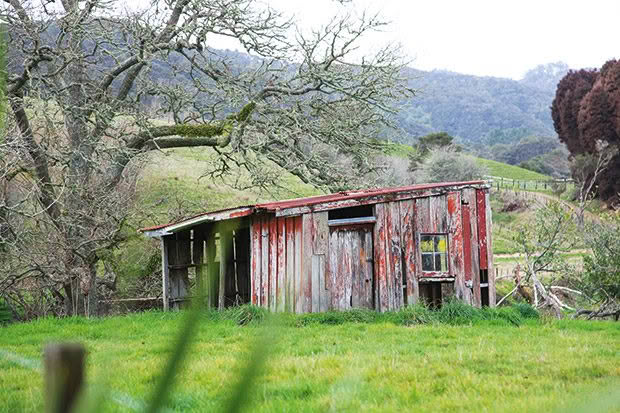
The last time the cottage was offered for sale was 1942, when an Auckland businessman bought it as a wartime bolthole for his family. They never made it their home and only frequented it occasionally, so it remained unoccupied, but never unloved.
Many a local lady – including me – stopped to swoon over its rocking-chair porch fringed with wisteria overlooking an old-fashioned garden of lavender, cherry blossoms, camellias, fragrant jonquils, snowdrops and peachy-pink heirloom ‘Souvenir de Madame Leonie Viennot’ roses (a rose so often seen scrambling over early-settler outhouses that it was unkindly dubbed “the dunny rose”).
The cottage was marketed in an “as is” condition, which in real estate lingo means you needn’t waste a buck on a pre-purchase building inspection because what you see is what you get. And what I got was a house with a rusty roof, rattletrap porch, borer-burrowed shiplap and scrim walls, and starlings squatting under the weatherboards, plus a little red barn in a state of disrepair.
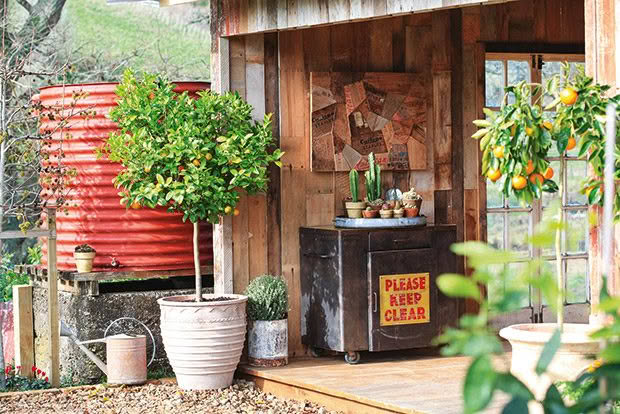
Potted citrus flank the open bay of the barn. Lynda’s Please Keep Clear cabinet came from her former city home, purchased at an exhibition of reworked industrial furniture by The Boiler Room artists Gary Willis and Susan Haldane. The Hurricane Fencing box artwork above the cacti collection is by Hamish Southcott.
That ramshackle barn had me at hello, for of all the utilitarian buildings I’ve renovated over the years – from sleep-outs to shepherd’s huts and stable blocks – I’ve never had a proper red barn to call my own. Farm barns, it has to be said, are traditionally a male domain. Barns are for big blokes and even bigger machines. Barns are practical places for Getting Stuff Done: for welding, working, fixing, making, toiling and tinkering.
The Oxford English Dictionary defines a barn as “a large farm building used for storing grain, hay or straw, or for housing livestock” but please don’t tell my barn, for it fails on all counts.
My wee barn is a place for being, not doing. For starters, it’s far too small, at 24 square metres, to store the hay we made last summer from the cottage paddock, although I do keep a bucket of grain in it to coax our chatty pet cayuga ducks up from the river for a chinwag. There’s no livestock to house, either, unless you count the rats, rabbits and possums we evicted during the renovation.
- Lynda’s son sprouted this kūmara tuber as a lockdown home-schooling project. After the last frosts, she’ll pluck off the runners to transplant.
- The japanese ume plum, Prunus mume, is the earliest and most beautiful blossom tree to break bud in spring.
- Lynda originally intended to hang dried flowers from the rafters of her barn, but rats and birds pecked them to bits to harvest the seed heads, so now she cuts fresh foliage and garden flowers to dangle above a seasonal display of potted flowering bulbs and a milk crate of cottage blooms. The oak table and chairs were made in the 1940s by the property’s former owner, furniture-maker William Dawn.
- A vintage butter churn sits on top of the old cream-separator post under Lynda’s wall of antique tools, some still in use, others upcycled with decorative floral transfers.
Did I say renovation? I meant demolition. When we started, I had hoped to prop up the barn’s sagging corner posts and patch its rotting red boards, but Jason diagnosed its degree of dilapidation to be fatal and promptly flattened it with his digger. We didn’t speak for days.
If my husband acted in haste, he repented at leisure, helping me sort the weathered planks and native timber posts into rotten bonfire fodder; and a stack for future furniture projects. We also piled up lichen-encrusted planks to piece back together as rustic cladding when the new barn rose from the ashes of the old.

Everything bar a new Colorsteel roof and truck-decking floor was recycled. We clad the back of the barn in the old roofing iron, lined the walls with the native flooring and ceiling timber from the cottage’s kitchen (it also fared poorly in a first date with Jason’s digger) and sourced second-hand windows and doors from the local demo yard.
At some point in its history, the cottage must have had a house cow, as the barn was originally configured as a cowshed with a main milking bay and adjoining creamery. Although Jason left the imposing timber post that would once have stabilized the cream separator jutting out of the floor, I’m hesitant to acquire a dairy cow.
There isn’t always wisdom in repeating history; my grandfather Albert was a gifted banjo player until an unfortunate incident with a cream separator left him with more strings than fingers with which to strum them.
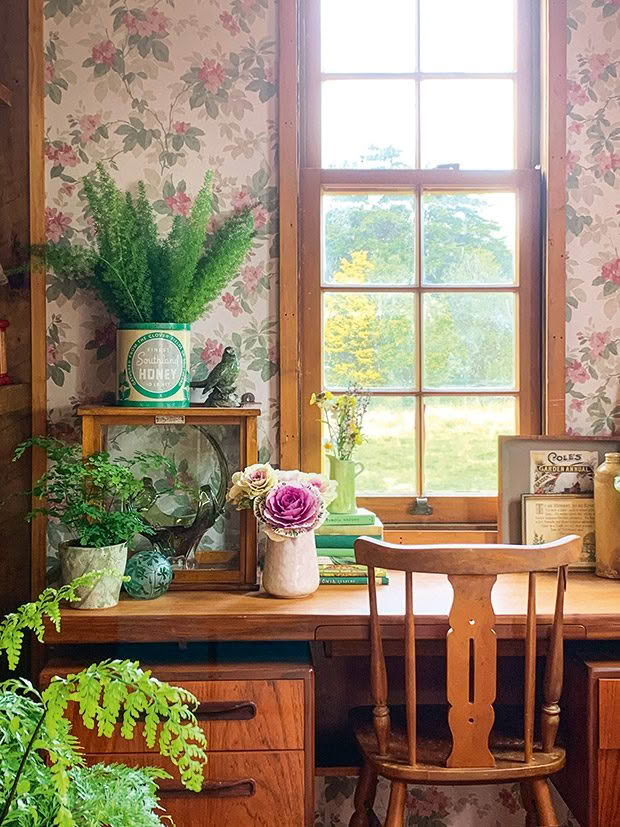
A she-shed deserves girly wallpaper. Lynda chose Silene from the Coordonne Botanika wallpaper collection to go above the 1960s G-plan Fresco desk in her barn’s writing room.
Despite the tools now hanging on its walls, my remodelled creamery isn’t designed to be a garden shed, as I don’t intend to do any actual work in it. I might sit at my desk and think about writing, à la Virginia Woolf (“a woman must have money and a room of her own if she is to write”), or I might populate it with parlour palms and posh houseplants and call it a garden room.
The idea of a garden room of my own has been germinating for a quarter of a century, specifically since Christmas of 1994, when my first boyfriend’s mum gave me a copy of The Garden Room by New York antiquarian bookseller Timothy Mawson.
“As one more inclined to green thoughts than green thumbs,” wrote Mawson in the book’s introduction, “the words ‘garden room’ have always had a mellifluous air, a suggestion of shelter and ease, a kind of casual charm. Garden rooms are unique in that they tend not to have a specific function and are designed primarily for pleasure.”
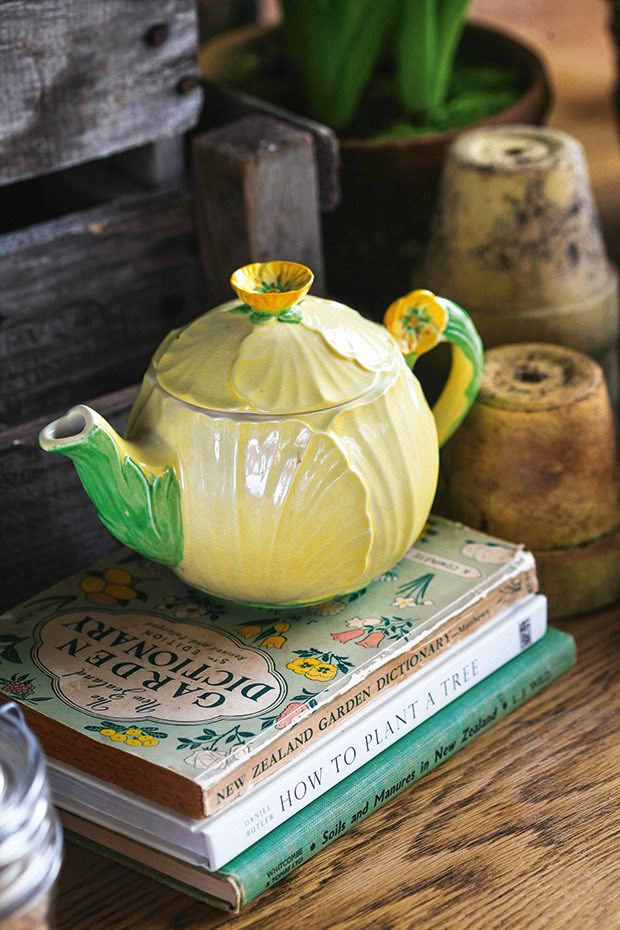
Barns, says Lynda, should be for pottering, plotting, planning and poring over old gardening books, perhaps with a cuppa poured from a 1930s Carlton Ware Buttercup teapot?
For a farm girl from the Waikato, back then the horticultural hideaways and al fresco aristo abodes of the New York glitterati seemed impossibly glamorous, but the creative corner I loved most belonged to Kiwi expat floral designer J. Barry Ferguson.
On page 74, I saw the light – literally – streaming through the window of his converted carriage house, with its antique desk, vases of red roses, potted caladiums and hand-painted faux-terracotta tiled floor and knew that one day, I too, would sit at an old desk under a window and do, frankly, as little as is womanly possible.
ABOUT LYNDA HALLINAN
Gardening journalist and broadcaster Lynda Hallinan was a Waikato farm girl before she became a city-slickin’ magazine editor. Ten years ago she followed her heart to the Hunua Ranges where, with her husband Jason and two boisterous boys — Lucas and Lachie — she’s getting the hang of country life again. foggydalefarm.co.nz
MORE HERE
 This article first appeared in NZ Life & Leisure Magazine.
This article first appeared in NZ Life & Leisure Magazine.
